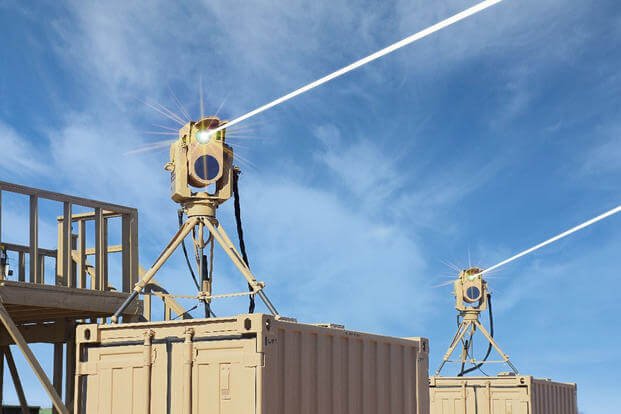The Marine Corps' ground-based laser systems, which can be mounted to the tops of vehicles to take down drones, now have stronger beams to combat airborne threats.
The Corps has a new $2.5 million agreement with Boeing to service its Compact Laser Weapon System for the next five years. The system, which can be attached to combat vehicles, can be used on land or at sea.
Boeing just completed a round of updates to the service's Compact Laser Weapon Systems, giving Marines the ability to take out bigger drones. The updates also made the laser weapon more reliable and faster, and they allow Marines to target more aircraft from greater distances, according to Boeing.
Read Next: Marines Under Investigation After Ammo, Explosives Reportedly Go Missing at Pendleton
The changes come as the top U.S. general in the Middle East warned last month that cheap, off-the-shelf drones pose the most concerning tactical development in that region since terrorists began using improvised explosive devices in Iraq and Afghanistan.
"These systems are inexpensive, easy to modify and weaponize, and easy to proliferate," Marine Gen. Kenneth McKenzie Jr., the head of U.S. Central Command, said last month.
The Islamic State group has used drones to fly IEDs. One such attack killed two Kurdish fighters in 2016.
Militaries are also using drones to target and surveil troops. Marines using another vehicle-mounted system in 2019 jammed at least one Iranian drone that flew within 1,000 yards of their Navy warship in the Strait of Hormuz, sending it plummeting into the sea.
The Compact Laser Weapon System doesn't just jam drones but destroys them. Josh Roth, a spokesman for Boeing's missile and weapon systems, said the lasers can take out what the Defense Department refers to as Group 1 and 2 unmanned aircraft, which weigh as much as 55 pounds and can operate below 3,500 feet.
Boeing's system also has a counter-sensor capability at longer ranges for larger targets, Roth said. The system uses software to spot and track a threat. Once a drone is spotted, the weapon system focuses a high-energy laser beam on the threat until it's disabled and defeated, he added.
Marines began testing the system, the first ground-based laser approved for military use, in 2019. The laser gives Marines a lightweight option to target drones, Roth said, since it can be carried and operated by just one person.
"It ... affords the warfighter the opportunity to save more expensive air defense missiles for other threats and reduces the logistics footprint by eliminating resupply needs for conventional ammunition," he said.
Roth declined to say how many of the laser systems have gone to the Marine Corps and what units received them, citing operational security. Marine Corps photos and videos show low-altitude air defense battalions on the East and West coasts testing the systems.
Last year, Marines tested the upgraded laser weapon in Yuma, Arizona, where they were able to take down 12 out of 12 drone threats, according to Boeing. Now, those upgraded systems have been delivered to Marine units, Roth said.
The system has also been used in real-world missions, though Roth declined to say where.
The Air Force tested it at Nevada's Nellis Air Force Base in September.
-- Gina Harkins can be reached at gina.harkins@military.com. Follow her on Twitter @ginaaharkins.
Related: Tiny Drones Are the Biggest Threat in the Middle East Since IEDs, Top General Says












